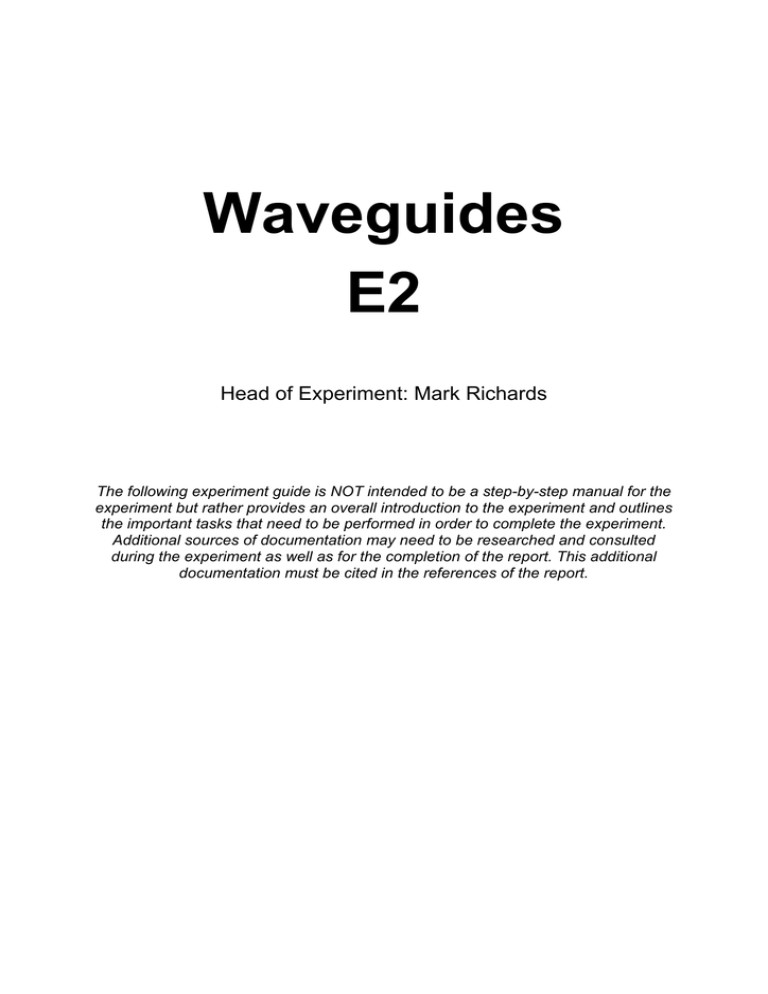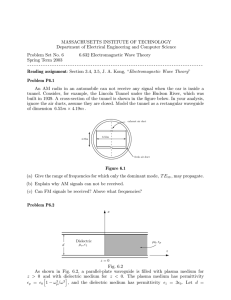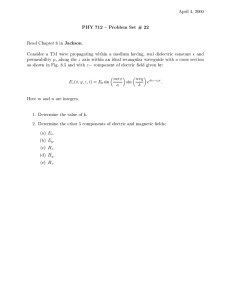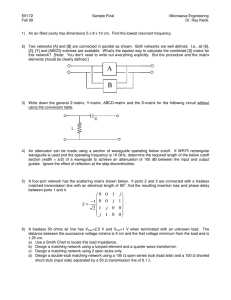Document
advertisement

Waveguides
E2
Head of Experiment: Mark Richards
The following experiment guide is NOT intended to be a step-by-step manual for the
experiment but rather provides an overall introduction to the experiment and outlines
the important tasks that need to be performed in order to complete the experiment.
Additional sources of documentation may need to be researched and consulted
during the experiment as well as for the completion of the report. This additional
documentation must be cited in the references of the report.
RISK ASSESSMENT AND STANDARD OPERATING PROCEDURE
1. PERSON CARRYING OUT ASSESSMENT
Geoff Green
Chf Lab Tech
Name
Position
2. DESCRIPTION OF ACTIVITY
Date
17/09/08
Room
410
E2 Wave Guide Experimenent
3. LOCATION
Campus
SK
Building
Blackett Lab
4. HAZARD SUMMARY
Accessibilit
y
X
Mechanical
Manual
Handling
Hazardous
Substances
Electrical
X
Other
X
Lone
Working
Permitted?
Yes
Permit-toWork
Required?
Yes
No
No
5. PROCEDURE
PRECAUTIONS
Use of 240v Mains Powered Equipment
Isolate Socket using Mains Switch before
unplugging or plugging in equipment
All bags/coats to be kept out of aisles and
walkways.
none
Accessibility
X-band microwaves
6. EMERGENCY ACTIONS
All present must be aware of the available escape routes and follow instructions in the event of an
evacuation
3rd Year Lab. Expt. B7: Waveguide experiments using microwave radiation
Waveguide Experiments Using Microwave Radiation.
1. Introduction
In this experiment, you begin by familiarising yourself with the practical aspects of waveguide measurements, and verify some of the standard results in waveguide theory. Then you are asked
to investigate the dielectric properties of certain materials at microwave frequencies.
1.1. Basic experimental configuration
A typical set-up for an experiment is presented as Figure 1. It consists of a source of
microwave radiation that is coupled into a rectangular waveguide. Various waveguide components
and dielectric materials can then be attached or positioned alongside this basic configuration.
Figure 1 basic experimental configuration
1.2. The Standing Wave Meter
The basic measuring device used in this experiment is the standing wave detector. This is a
section of waveguide with a longitudinal slot, through which a sliding probe is inserted to sample the
electric field, E, inside the waveguide. A diode in the probe mounting rectifies the microwave signal
and, if operated in the correct signal strength regime, this signal is proportional to the square of the
electric field, E2. (why do you think this is?)
The standing wave ratio or SWR for a waveguide is defined as the ratio of maximum to
minimum electric field strength in the waveguide,
SWR =
Emax
Emin
Since the minimum of the electric field can vary from 0 to Emax then 1 ≤ SWR ≤ ∞ .
(1)
3rd Year Lab. Expt. B7: Waveguide experiments using microwave radiation
1.3 Measuring the standing wave ratio
The signal from the probe is measured using a lock-in amplifier. To obtain a measurement of the
SWR:
1. Connect the probe to the input on the SWR meter.
2. Ensure that the PIN diode modulator is connected to the PIN socket and the modulation
source selector switch is set to ‘PIN INT’
3. Set the meter gain knob (V/dB) to the least-sensitive setting (farthest anticlockwise)
4. Slide the probe along the slot and adjust the gain setting to get a reading on scale that varies
with position.
5. Move the probe along the slot to get a maximum on-scale reading (needle farthest to the right)
6. Use the gain setting and zero knob to set the needle to 1.0 on the SWR scale (the scale below
the mirror). This sets a reference for Emax to 1.0
7. Slide the probe along the guide until you get a minimum needle deflection (high SWR
reading). Read the SWR from the needle position
8. Alternatively take readings of the voltages at the AMP-OUT connector on the meter. This
provides an analog voltage that is proportional E2,and so the SWR can be calculated from the
ratios of the signals at minimum and maximum positions. This may give more
precise/accurate values especially for high SWR readings
1.4 The microwave source
The microwave oscillator itself is a Gunn diode mounted in a waveguide cavity. When
operated in a specific voltage range the charge carriers in this diode experience a negative differential
resistance causing them to oscillate at microwave frequencies. This negative resistance can be
observed by looking at how the current through the diode (IG) varies with the voltage across it (UG)
using the meter on the Gunn diode power supply These oscillations can be stabilised (& tuned) by
coupling them to a resonant cavity. For stable operation the voltage across the Gunn diode should be
in the region of 8-10V. The oscillations in the cavity are coupled to the hollow waveguide whose
lowest frequency normal mode for electromagnetic oscillations is near 1010 Hz i.e. a free space
wavelength, λ~3cm. To prevent back reflections from disrupting the output of the Gunn oscillator an
isolator is incorporated in the set-up.
In the standard arrangement on the waveguide bench (see Figure l) the oscillator unit and
standing wave detector are connected via an isolator, a PIN modulator and then an attenuator.
Attenuation is produced by the absorption of energy in a lossy dielectric plate that can be moved
across the waveguide by a micrometer screw. Attenuation is usually measured in decibels (dB): if
P1and P2 are the two power levels then the attenuation in decibels is 10log10(P1/P2). A scale of
attenuation versus micrometer position is provided on the attenuator housing.
The separate sections of waveguide are joined together by clamping screws which align the
sections accurately and make a good mechanical and electrical contact. For permanent fixing screwed
clamps are convenient. However, if frequent changes have to be made a different type of coupling can
be employed. This uses 'quarter-wave flanges', as sketched in Figure 2, where the distance
d ~λ/4 ~ 0.75cm.
3rd Year Lab. Expt. B7: Waveguide experiments using microwave radiation
d
Figure 2 – a quarter wave flange.
When the λ/4 flanges are used for coupling, the waveguides must be aligned, and the flange
surfaces made parallel, by adjustments to the stirrups which support the waveguides on the waveguide
bench. The flange surfaces should be close together, but not touching (a sheet of paper makes a
suitable spacer). This arrangement provides excellent electrical continuity across the junction at
microwave frequencies.
By thinking of the rectangular flanges as forming separate little waveguides, which support
oscillating fields with a standing wave pattern at 90° to the main waveguide, can you explain why
these flanges produce a field pattern in the main guide which is similar to a perfect join?
2. Experiments illustrating the behaviour of E.M. Waves in a waveguide
2.1 Relation between the free-space wavelength and wavelength in the waveguide
Fix a metal plate across the end of the waveguide of figure 1, so creating a "short-circuit" at
this point in the waveguide. Measure the standing wave ratio (SWR), and record the profile of the
standing wave pattern along the waveguide from readings of the probe at various positions in the
standing wave pattern, deduce the wavelength in the guide, λg.
Note the position of the probe can be read either from the vernier scale on it or alternatively
an electronic measure of the probe position can be obtained by applying a maximum voltage of 10 V
to the position sensor input and recording the output from the ‘x’ position output. (The reading from
this output is directly proportional to the probe position but it will need to be calibrated).
The bulk of the measurements you will be making involve determining positions of maxima,
minima and standing wave patterns like this. It is worth taking some time now to design an
experimental method which yields the highest possible accuracy, and to think how you will estimate
this accuracy.
Next, with the probe located at one of the standing wave minima, slowly move the shortcircuit plate away from the end of the waveguide. This can be done conveniently by fixing it to the
end of another section of guide which can slide on its supporting stirrups (figure 3). The measurement
can be improved by connecting a horn to the end of the guide and using a larger flat vertical plate
mounted on the optical bench for the reflector. What is the largest value of 'x' for which interference
can be detected?
3rd Year Lab. Expt. B7: Waveguide experiments using microwave radiation
Figure 3. Typical arrangement for measuring the free-space wavelength.
Record the values of the separation (x in figure 3) for extrema occur in the probe output. Provided x is
not too small (why this restriction?) the situation is analogous to that in optical interference
experiments, and from the measurements deduce a value for the wavelength in free space.
Now check the theoretical relation linking λ and λg (see appendix) namely:
1
λ
2
g
=
1
λ
2
−
1
(2)
λ 2c
where λc is the cut-off wavelength equal to twice the longer dimension of the waveguide crosssection.
2.2 Resistive and Reactive Terminations
Section 2.1 began with a "short-circuit" metal plate across the waveguide. Eventually, as the distance
'x' in figure 3 became large without limit, this "short-circuit" was completely removed. The question
now arises, is the net result equivalent to an "open circuit"? If so, nodes and antinodes should still
exist, but with an antinode instead of a node at the termination.
Original SW
pattern
Shift in minimum
Added
capacitance
New SW
pattern
λ/4
Original open
circuit
Figure 4. Illustration of a capacitive termination
Measure the standing wave pattern obtained in practice, i.e. record the standing wave ratio
and the location of the maxima and minima. (you will need to remove the horn if you previously used
one) From these measurements it is possible to characterise the termination by its "effective
impedance" relative to the "characteristic impedance" of the waveguide, considered as a transmission
line, with the aid of the following notes.
3rd Year Lab. Expt. B7: Waveguide experiments using microwave radiation
Useful transmission line relations
A lossless transmission line has a wholly resistive characteristic impedance, Rc When such a line is
terminated by a resistance RL the reflection coefficient r is given by
r=
R L − Rc
R L + Rc
(3)
Thus r is a real number, implying no phase shift on reflection (other than perhaps a change of sign).
The standing wave ratio, which in the general case is given by
SWR
=
1+ r
1− r
(4)
may here be expressed more simply as RL/Rc or Rc/RL , depending on which of these ratios is less than
1. For RL>Rc the standing wave pattern has a maximum at the termination: for RL<Rc it has a
minimum. For any resistive termination, the maxima or minima will be located at multiples of λg/4
from the termination, where λg is the wavelength on the line.
A different location of the maxima and minima must accordingly be attributed to a reactive
component in the terminating impedance. In general, it can be shown that if the standing wave pattern
has a minimum within λg/4 of the termination, the terminating impedance is capacitive. This is readily
understood if one thinks of the capacitance as a short section of line extending beyond what was
originally an open circuit; as in Figure 4. Correspondingly, when the termination is inductive, the
minimum is displaced in the opposite direction, and occurs between λg/4 and λg/2 from the
termination.
The results summarised above are sufficient for a qualitative analysis of the measurements
obtained in this and later experiments. In your report discuss the physical interpretation of a finite
resistive component in the terminating impedance and consider whether the sign of the reactive
component can be understood using elementary ideas about "end effects" i.e. the shapes of the electric
and magnetic fields under a particular type of terminating geometry and whether these can be
interpreted as an inductive or a capacitive effect.
2.3 Absorption without reflection: the matched load
It will be clear from the experiments above that a sudden discontinuity in a waveguide, such
as the short circuit plate or a terminating flange into free space, usually involves the production of a
reflected wave. Only in the special case when the termination is non-reactive and has the same
resistance as the waveguide characteristic impedance is an incident wave totally absorbed.
A simple way to obtain absorption without reflection is to arrange for a gradual transition, extending
over several wavelengths, between the standard waveguide and one filled with a strongly absorbing
dielectric. A convenient dielectric to use is wood which at the frequencies used here has a complex
dielectric constant ε = ε´-iε΄΄. The ratio ε΄΄/ε΄ or "power factor" is a measure of the departure from
ideal dielectric behaviour: for small ε΄΄/ε΄a travelling wave has its energy reduced by factor 1/e in a
distance (ε΄΄/ε΄)λ/2π.
Figure 5. Absorption using a matched load.
3rd Year Lab. Expt. B7: Waveguide experiments using microwave radiation
Set up the arrangement of Figure 5, in which a long wooden wedge is inserted into the
waveguide, and couple it to the standing wave detector by means of the quarter wave flanges.
Measure the standing wave pattern and ratio. Provided the waveguides are properly aligned and the
flanges close together, the measured standing wave ratio should be < 1.05. Check that obstructions
(e.g. metal) inserted beyond the thick end of the wedge have only a slight effect on the SWR. If needs
be, introduce additional wood until this is so. Compare the performance of the wooden matched load
to that obtained with the commercial termination (part No 73714).
2.4 Characteristics of the coupling flanges
The good SWR measured for the wooden wedge in section 2.3 depends in part on the
effectiveness of the λ/4 flanges used to couple it to the standing wave detector. To check their
performance, measure the SWR as the spacing between the flanges is increased from 'close' to ~5 mm.
Why does the SWR deteriorate as the spacing increases?
Compare these measurements with the SWR obtained using the standard screw couplings.
2. 5 Reflection from metallic intrusions
With the terminated arrangement of section 2.3, insert a sheet of copper between the λ/4 flanges so
that it protrudes into the waveguide from, firstly, the broad side of the guide and, later, from the
narrow side.
In both cases, the obstruction causes reflection, and a standing wave pattern will be
produced. Observe the location of the standing wave minimum in each case, and compare it with that
for a complete short-circuit at the λ/4 flanges, as measured in sections 2.1 and 2.2. Hence deduce the
nature of the induced impedances (resistive/capacitive/inductive). Interpret your conclusions by
making sketches of field lines in the waveguide in the vicinity of the intrusion.
3rd Year Lab. Expt. B7: Waveguide experiments using microwave radiation
3 Properties of Materials at Microwave Frequencies Measurement of the
dielectric constant
The wavelength λg in a waveguide is related to the wavelength of infinite plane waves in an
unbounded medium by the basic equation already quoted:
1
1
1
= 2 − 2
2
λg
λ
λc
where the cut-off wavelength λc depends on the dimensions of the waveguide. To understand
propagation in the same waveguide when it is filled with dielectric one need merely recall that
infinite plane waves in the unbounded dielectric have wavelength λ΄=λ/√ε. Hence the guide wavelength, with dielectric, is λ΄g where
1
λ
/2
g
=
1
λ
/2
−
1
λ 2c (5)
There is no change in λc since the guide dimensions are unaltered.
The experiments that follow are designed to measure λ΄g. Once λ΄g has been measured, it is easy to
calculate λ΄ and so to obtain the dielectric constant as (λ/λ΄)2.
3.6 Dielectric Constant of Wood
I
r
t
Figure 6. Arrangement for determining the dielectric constant of wood and Perspex
Use the same arrangement as used in section 2.3, but reverse the orientation of the wooden
wedge, so that its wide end faces the Gunn oscillator, and is flush with the λ/4 couping flanges. There
is now a discontinuity as the incident waves meet the wood, and partial reflection takes place because
of the sudden change in dielectric constant. Measure the standing wave ratio and the position of the
standing wave minimum. Note that the wood surface is located where the short-circuit was placed in
earlier experiments.
It can be shown that the standing wave ratio is given by
SWR =
λg
λ g′
(6)
the proof comes by applying the boundary conditions that E and dE/dx must be continuous across the
surface, and supposing there are only three waves involved, incident, reflected, and transmitted with
relative amplitudes I, r, and t. (How do the boundary conditions quoted relate to Maxwell's equations?
Note the similarity in the calculation to the well-known problem of a potential step in quantum
3rd Year Lab. Expt. B7: Waveguide experiments using microwave radiation
mechanics). Hence, with λg already known from experiment 1, one obtains λ΄g. The waveguide
equation then yields λ and λ΄, whence ε = (λ/λ΄)2
No specific reference is made in the calculation to the position of the standing wave minimum. Where
is it located, and what inference do you draw from its position?
3.7 Dielectric Constant of Perspex
Replace the wooden wedge of experiment 6 with a perspex wedge, and use the wooden wedge or the
matched load as a matched termination further down the guide (figure 6). The matched termination
ensures that only the transmitted wave 't' is present on the perspex side of the discontinuity. (A
termination was not needed in experiment 6 because the wood is sufficiently absorbing by itself to
attenuate any return wave from the far end of the guide).
The analysis proceeds exactly as in section 3.6.
3.8 Dielectric constant of polythene
Polythene blocks of 3 different lengths, l, are provided, which can be inserted on the standing wave
detector side of a short-circuit plate as shown in figure 7.
x
Polythene block
l
II
I
Figure 7. schematic for derivation of the standing wave when a dielectric is inserted into the waveguide.
The measured SWR should be very large, since no appreciable power absorption occurs in a highquality (i.e. low conductivity) dielectric like polythene. The location of the standing wave minima can
be measured, and from this can be found by the following analysis.
Since there must be a node at the short circuit, the standing wave pattern in the polythene (region I,
0<x<l) has the form
⎛ 2π x
E = sin ⎜ /
⎜ λ
⎝ g
⎞
⎟
⎟
⎠
(7)
In region II, we have
⎛ 2π ( x + x o ) ⎞
⎟
E = a sin ⎜
⎜
⎟
λg
⎝
⎠
where a and x0 are arbitrary amplitude and phase parameters.
(8)
Applying the boundary conditions that E and dE/dx must be continuous at x = l leads to the relation
3rd Year Lab. Expt. B7: Waveguide experiments using microwave radiation
⎛ 2π l ⎞
⎛
⎞
⎟ = λ tan ⎜ 2π ( l + x 0 ) ⎟
g
⎜ λ/ ⎟
⎜
⎟
λg
⎝ g ⎠
⎝
⎠
λ /g tan ⎜
(9)
Of the quantities in this equation, x0 can be deduced from the location of the standing wave minimum,
l can be measured directly, and λg is known from experiment 1. So the right hand side can be
evaluated.
The equation is however “Transcendental” so can only be fully solved either graphically (by plotting
the LHS as a function of λ΄g to find what value of λ΄g will yield equality of the two sides, or
numerically in a programmable calculator or computer. Either way, note that the equation is multivalued (to chose the right value remember that all the polythene blocks you have are much thinner
than a wavelength) and be sure to think carefully about how your experimental error in the
measurement of λg will propagate through to the error on your value for λ΄g.
Having found λ΄g and λg the computation of ε proceeds as before.
3rd Year Lab. Expt. B7: Waveguide experiments using microwave radiation
Appendix: Basic Waveguide Properties
Consider the interference pattern produced by two equal sources S1and S2, radiating e.m. waves of
wavelength λ and velocity c, in phase, and with polarisation such that E is perpendicular to the paper.
Min E
W
θ
θ
Max E
Min E
Energy flow along
Ox, velocity c cosθ
E
θ
θ
O
x
The line of symmetry Ox marks an interference maximum (or 'bright fringe'). On either side of Ox the
fringe system forms a set of near parallel lines, which become accurately parallel when the source
distances are great. For a point P at distance y from Ox the path difference (S1P-S2P) is 2ysinθ, hence
the first interference minimum ('dark fringe') occurs at y0 where 2y0 sin θ =λ/2. The separation w
between the dark fringes at +y0 and -y0 is therefore
λ
w
=2
y
0=
s
in
()
θ
Between +y0 the energy flow is along Ox, with a velocity of propagation c cosθ, since the outward
flow from S1and S2 (at velocity c) makes angle θ with Ox.
The dark fringe minima at +y0 are true zeros when S1 and S2 are remote, since the interfering
amplitudes are equal. No disturbance to the fields present need therefore follow if we put metal plates
at +y0 perpendicular to the paper. Similarly, metal plates can be used parallel to the paper (and
therefore perpendicular to E) without causing perturbing the field distribution. We can see that a field
distribution of this type is supportable within a conducting rectangular pipe.
Although the waves from S1 and S2 have a free space wavelength λ, their crests intersect Ox at
spacings λg =λ /cosθ and the intersections move with a phase velocity vph=c /cosθ . This Phase
velocity should not be confused with the group velocity, vgr. Vgr corresponds to the velocity of
energy flow, which we have already seen is Vgr = c cosθ.
The angle θ is a useful parameter to describe the waceguide characteristics, but in practice the primary
quantity determining how a given waveguide will behave is the dimension w, the longer side of its
3rd Year Lab. Expt. B7: Waveguide experiments using microwave radiation
cross-section. Since w=λ/2 sin θ it follows that θ = sin-1 (λ/2w) and so the waveguide can only
support modes with λ<2w for these equations to have solutions. The parameter 2w is known as the
“cut-off” wavelength, λc .
Thus we have sinθ = λ/λc and so cos2θ = 1-(λ/λc)2. Substituting these in the above expressions
yields…
S1
λ
λ
x
λ/cosθ
1
λ
2
g
=
v ph =
1
λ
2
1
−
λc2
c
1− λ
b
2
λ2c
vgr = c 1− λ
2
and
λ2c
which are the principle waveguide relations.
The field patterns for E and H in the waveguide can be sketched in by inspection from the known
patterns of E and H in the transverse waves radiated by S1 and S2. This yields the result below, the
whole pattern moving with vph. Note that along Ox the Poynting vector E^H correctly indicates the
direction of energy flow.
Min E
W
H
E
Max E
H
E
Min E
E
Energy flow along
Ox, velocity c cosθ




